1985 Australian Grand Prix race report

Keke Rosberg leads Ayrton Senna on his way to winning the last race of the season
Motorsport Images
Australian Grand Prix
Adelaide, November 3rd
Perhaps wondering inwardly whether he was doing the right thing moving to the McLaren International line-up, Keke Rosberg underlined that he is possibly the best driver in the business when it comes to “improvising” on a new track, or handling a new street circuit, by taking his WilliamsHonda FW10B to a superb victory in the inaugural Australian Grand Prix at Adeaide. Held over the 2.347-mile circuit laid out in the eastern suburbs of this “City of the Churches”, the race was both supported and vigorously promoted by South Australia’s energetic Premier John Bannon and it says a lot for his influence in high places that the country’s Prime Minister Bob Hawke took time off to attend this major sporting event on the day.
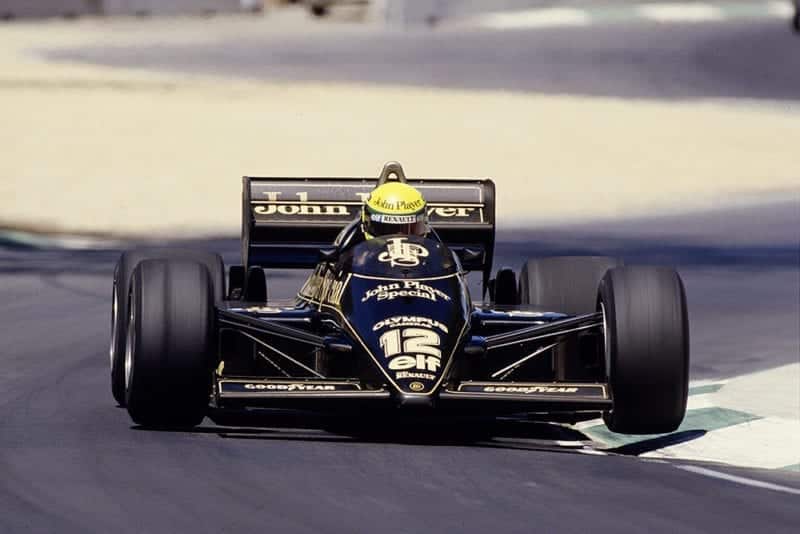
Ayrton Senna took his 7th pole of the season for Lotus
Motorsport Images
Within the Formula One fraternity there was a fair deal of muttering and groaning about the prospect of a race so far away from Europe rounding off the international calendar, but most people’s preconceptions about Australia were blown away on a pleasant breeze of enthusiasm when they arrived in this attractive city and came face to face with the enormous enthusiasm and willingness to get things done right which was radiated by everybody involved in the race organisation. The circuit used both city streets and a section of purpose-built circuit which wended a path through the centre of Adelaide’s Victoria Park horse racing track, but the blend was just right, not too tight nor too fast, and the only aspect the drivers found themselves complaining about was the surface itself which proved remarkably smooth and slippery throughout official qualifying.
The battle for pole position was waged with tremendous ferocity between the two Williams-Honda FW10Bs and Ayrton Senna’s Lotus 97T, the Brazilian finally settling the issue with a stunning 1 min 19.843 sec on his second run during Saturday qualifying. Senna was the only competitor to break the 1 min 20 sec barrier and he lined up immediately in front of Nigel Mansell and Keke Rosberg, the English Williams driver in confident mood following his recent successes at Brands Hatch and Kyalami and anxious to sustain that successful trend.
Race
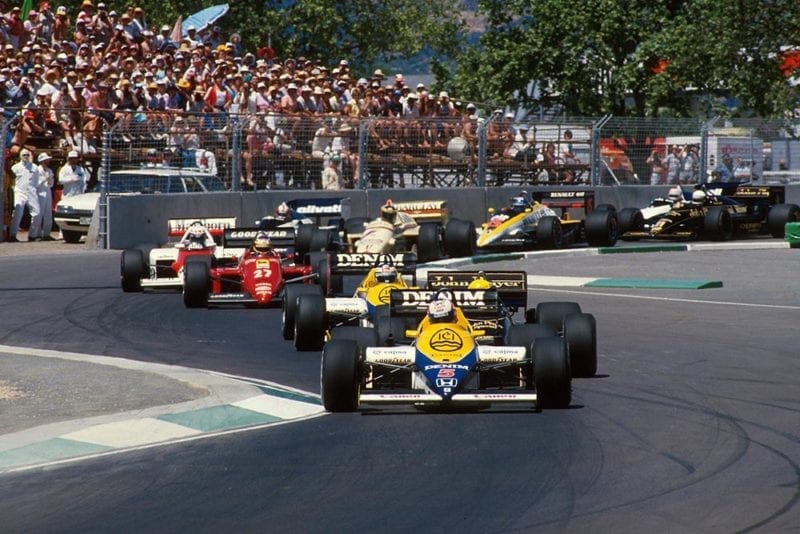
Nigel Mansell leads at the start
Motorsport Images
Mansell managed to out-accelerate Senna away from the line and scrambled through the first chicane ahead to lead away up the next hill into a sequence of 90-degree rightand left-hand corners which bring the cars out onto the long back straight. However, Senna was not hanging around waiting for his rivals to make a mistake and forced his way down the inside of the leading Williams going into the second tight left-hander, forcing Mansell out over the kerb and losing so much of his own momentum that Rosberg slipped past the Lotus into the lead. Predictably, neither Senna nor Mansell could agree who was at fault and the latter’s indignation was further fuelled when he stopped for good after two laps with a damaged crownwheel and pinion.
Senna took a bit of a risk diving inside Mansell on such a tight line so early in the race, but he dismissed the incident as “Mansell trying to stay with me round the outside of the corner when there wasn’t enough room”. Either way, this little first lap drama allowed Rosberg into the lead, the Finn lapping confidently and well within his limits, confident that the cast iron brake discs fitted to his FW10B would stand up to the rigours of the 82 lap race in these sweltering conditions far better than the carbon fibre discs used on the pursuing Lotus 97T.

Renault’s Patrick Tambay fights through the midfield pack
Motorsport Images
Although Senna got quite close to Rosberg in the opening stages of the race, the Williams-Honda’s straight line speed ensured that it stayed ahead without too much drama. The pedal pressure required to use the cast iron brake discs effectively on this tight circuit was giving a troublesome nerve on the ball of Keke’s right foot a good deal of gyp throughout the race, but by lap 26 the Finn had opened out almost half a minute’s advantage over the Brazilian. He then slowed slightly to conserve his graining tyres, allowing Senna to close up onto his tail by lap 42 and it was clear that the Brazilian would soon be looking for a way through.
Not that Senna’s race had been a model of circumspect consistency – for much of the time it certainly did not look like the man we have come to accept as the most impressive driver in the Formula 1 business. As he grappled to keep on terms with Rosberg in the opening stages of the race Senna was banging his Lotus-Renault up, over, and across the kerbing on the exits of the corners. On one occasion he shot so far off the circuit that it did not look as though he would retrieve the situation, but he gathered everything up again in a masterly fashion and went storming off after the Williams.
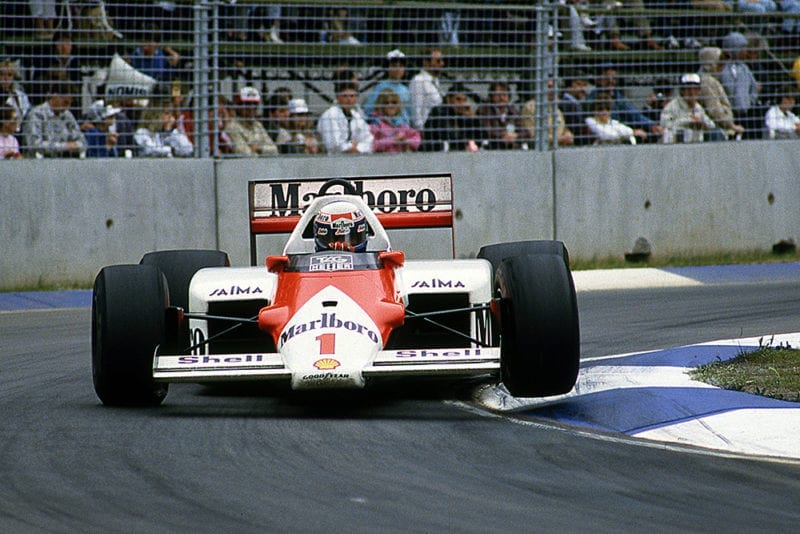
Alain Prost went out on lap 26 with engine failure
Motorsport Images
The pit lane entrance road at Adelaide begins just beyond the apex of a right-hand kink which leads into the braking area for the tight hairpin prior to the pit straight. Any car wishing to enter the pits must begin braking as it goes through that right-hand kink, so any pursuing driver must alter his line through that kink to avoid the slowing car. That is precisely what Senna found himself unable to do at the end of lap 42 when Rosberg chose to back off suddenly and head for the pit lane. The right front nose aerofoil on the Lotus was whipped off as it made contact with the lower edge of the Williams’ left rear aerofoil side plate, but the impact was so gentle that Rosberg maintained he just had not felt it and didn’t realise there had been any sort of incident until he examined his car in the scrutineering area once the race was over.
Obviously unable to enter the pits on this occasion, Senna pressed gamely on round another lap with the Lotus pit crew now all prepared to receive their leading runner, waiting with fresh tyres and a replacement nose cone. But, at precisely the same point as he hit Rosberg, Senna understeered onto the grass on the opposite side of the track, the impact ripping off the left front aerofoil as the Lotus careered along the grass in a cloud of dust before regaining the circuit just beyond the apex of the hairpin. Next time round Senna finally came into the pits, by which time Rosberg was able to storm back into the lead having made up time lost in his first pit stop.
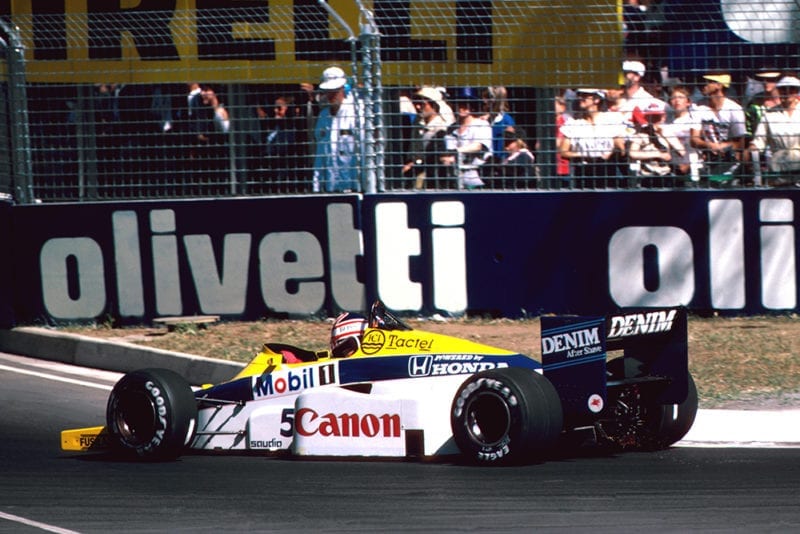
After a promising start, Mansell’s transmission gave out before the end of lap 1
Motorsport Images
Senna resumed behind Niki Lauda’s McLaren MP4/2B, the Austrian driving his last race for the team in typically meticulous style. But on lap 53 Rosberg came in for a third set of Good years and a disappointingly long stop – caused by a sticking front wheel retaining nut – dropped him back to third place. Senna was now ahead, but Lauda neatly outbraked him to take over the lead at the end of the back straight on lap 56. For_a few fleeting moments it seemed as though the Austrian was about to finish his career on the most impressive note possible, but, unbeknown to the crowd, he had been grappling with fading brakes for several laps and had his hands more than full keeping the McLaren in a straight line under hard braking. Two laps later the car got away from him, locked a rear wheel and sent him gently into the concrete retaining wall, damaging the car’s left front suspension badly enough to put him out of the race.
This left Senna ahead of Rosberg, but Keke caught him easily and was just about to pounce when the Brazilian slowed, waved him through and pulled into the pits enveloped in a thin haze of oil smoke. The Renault engine had broken in a big way, so Senna was out, leaving Rosberg with such a huge margin over his pursuers that he could afford the luxury of a third tyre stop in the closing stages without unreasonably jeopardising his advantage.
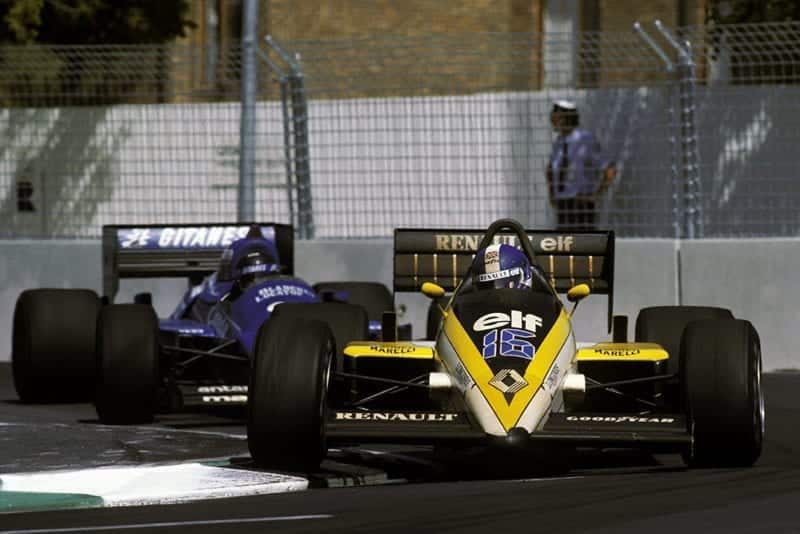
Renault’s Warwick also fell victim to transmission failure, retiring on lap 57
Motorsport Images
After Alain Prost’s early challenge for third place had evaporated with a broken engine (the Frenchman started from fourth place on the grid), Michele Alboreto looked as though he might be in a position to score a decent result for Ferrari. Although the 156/85s had not handled particularly well round this street circuit during qualifying, Michele found that the new revised turbochargers improved the V6 engine’s top end response quite appreciably and was happy to qualify fifth ahead of Marc Surer’s Brabham. Just when the Italian seemed set for a possible third place, a bolt fell out of the Ferrari’s gearchange linkage in the cockpit and he was obliged to retire.
All this drama allowed Jacques Laffite and Philippe Streiff to bring their LigierRenault JS25s through to second and third places at the finish, although there were some tense moments in the dying laps of the race as the new boy caught the old hand, culminating in Streiff breaking his left front suspension against Laffite’s right rear wheel as they jostled for position at the end of the back straight. Streiff later claimed that he had misunderstood his team-mate’s signals and was worried about another car catching him up, but Laffite made it pretty clear that he was not impressed about this excuse. Streiff hobbled round the last lap, lucky that his car held together in its crippled state, before joining Rosberg and Laffite on the podium.
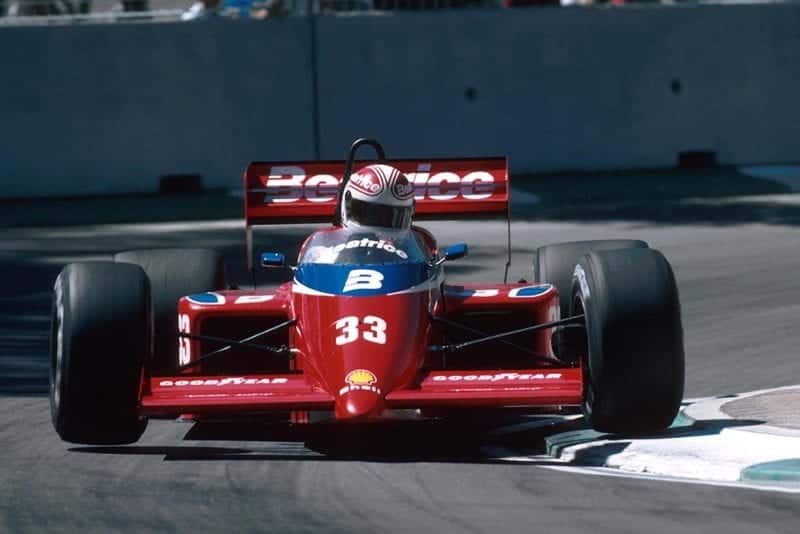
Local hero Alan Jones stopped with electrical issues on lap 20
Motorsport Images
The remaining classified finishers comprised a mixed bag who had managed to keep· out of trouble on a circuit which seemed quite hard on machinery. Novice Ivan Capelli kept his Tyrrell 014 away from the unyielding walls, making up for a practice shunt to finish fourth, while Stefan Johansson just outfumbled Gerhard Berger to ensure Ferrari beat Arrows for fifth place. Huub Rothengatter’s Osella and Pier-Luigi Martini’s Minardi were the only other cars still circulating at the end, although the small number of finishers in no way detracted from the intensity and enjoyment of the day’s proceedings as a whole.
Neither Brabham finished: Nelson Piquet rounded off his association with the marque by hopping out of the cockpit quite smartly when the battery began to smoke, the result of an electrical short-circuit, while Surer’s engine cut out and he was unable to restart while limping back to the pits with a deflated front tyre. Thierry Boutsen’s Arrows spun off on its own lubricant when an oil pipe fractured, both Renault RE60Bs finished the Regie’s involvement as a works team by breaking their transmissions and the Alfa Romeo 184TBs suffered engine failure. Elio de Angelis found his Lotus career ending on a low mark when he was blackflagged and excluded for making up places on the parade lap and Alan Jones’s Lola-Hart, after being left on the grid, stormed through to a fleeting sixth place before being sidelined with electrical trouble.

Gerhard Berger put in another impressive performance in his Arrows to finish 6th
Motorsport Images
If the Australian Grand Prix should get better as its organisation gains more experience, Formula One should be in for a real treat in the years to come. It would have been difficult to imagine a more invigorating manner in which to round off the ’85 season than the race we were lucky enough to witness in Adelaide. Anybody who passed up a chance of going must now be green with envy… -A.H.
Results
Australian Grand Prix – Formula One – 82 laps – Adelaide – 3.778 kms per laps – 109.796 kms – Sunny and hot
1st: Keijo Rosberg (Williams-Honda FW10B/7) 2 hr 00 min 40.473 sec – 154.032 kph
2nd: Jacques Laffite (Ligier JS25/5) 2 hr 01 min 26.603 sec
3rd: Philippe Streiff (Ligier JS25/4) 2 hr 02 min 09.009 sec
4th: Ivan Capelli (Tyrrell 014/2) 1 lap behind
5th: Stefan Johansson (Ferrari 156/85-086) 1 lap behind
6th: Gerhard Berger (Arrows A8/2) 1 lap behind
Fastest lap: Keijo Rosberg (Williams FW10B/7) on lap 57 in 1 min 23.758 sec – 162.382 kph

Rosberg takes the plaudits after winning his last race Williams
Motorsport Images
